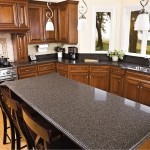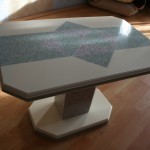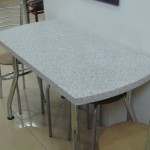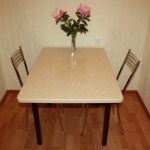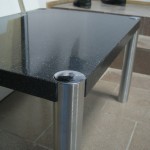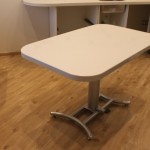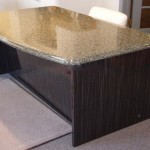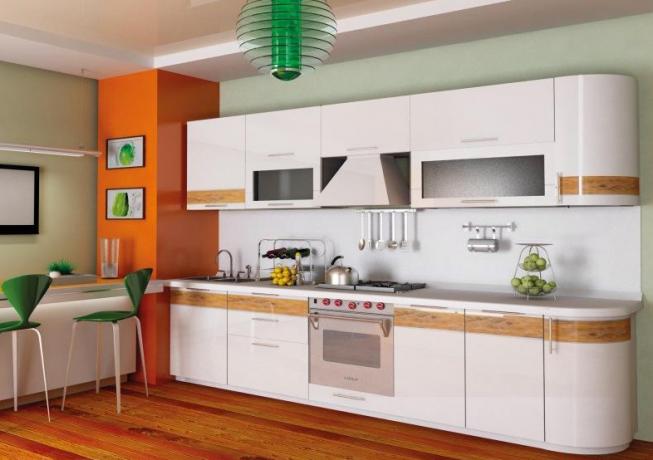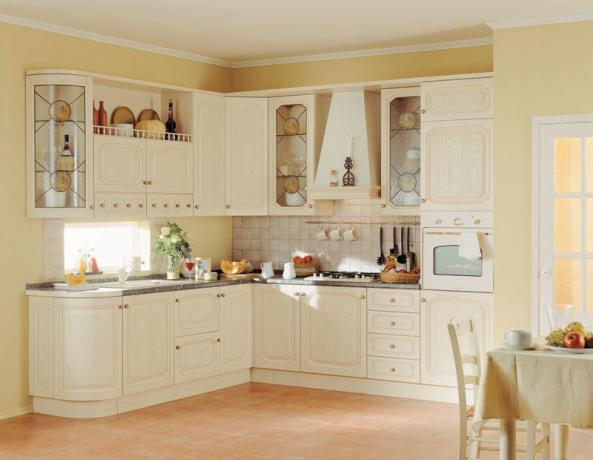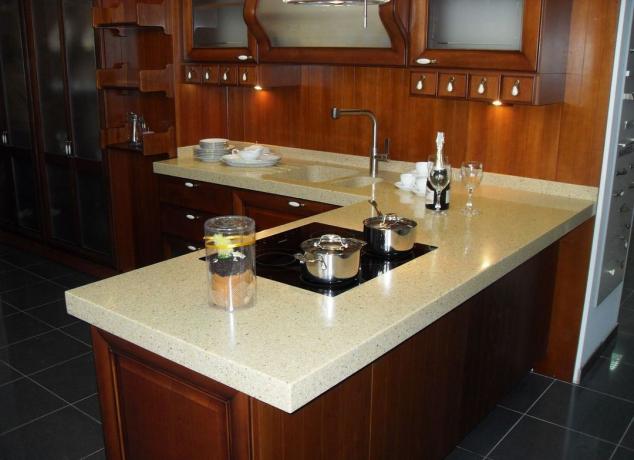Content
-
1 Features of artificial stone countertops
- 1.1 Main properties and advantages
- 1.2 Colors and shapes
-
2 How to choose size and shape
- 2.1 Shape selection
- 2.2 Determining the optimal size
- 3 Conclusion
The greatest load in the kitchen falls on horizontal surfaces: worktops and dining tables. They are constantly exposed to moisture, heat, heavy and sharp objects, etc. In order not to worry about their appearance and performance, many people choose kitchen tables made of artificial stone - one of the most durable, durable and aesthetically pleasing materials.

Stone worktop with built-in hob
It is a composite material made of polymer resins and filler - natural stone chips. Artificial stone sometimes has better strength characteristics than, for example, natural marble. At the same time, it looks no worse, and its price is lower.
Features of artificial stone countertops
The properties and appearance that kitchen tables with stone have depend on the composition of the composite material: the proportions of resin and filler, the type of stone chips. The filler can be:
- Limestone;
- Quartz sand;
- Marble chips;
- Granite chips, etc.
Main properties and advantages
The agglomerate from which the countertops are made has excellent operational properties, including:
- High compressive and flexural strength;
- Absolute moisture resistance;

Artificial stone is not afraid of water - even kitchen sinks are made of it
- Resistant to abrasion and scratches;
For reference. Stone kitchen tables are not afraid of cuts: you can cut food on them without a cutting board.
- Resistance to temperature extremes;
- Environmental friendliness of the material;
- The ability to maintain its original shape throughout the entire service life;
- Antibacterial properties, etc.
The only thing such tables are afraid of is the effects of acids, from which stains can remain on the surface. However, they do not penetrate deeply and can be removed by grinding.

Surface grinding
The disadvantages of products made of composite materials include them heavy weight, which causes problems with delivery and the need to make a sufficiently strong underframe.
Note! Large tables cannot always be delivered to the apartment by hand or by lift due to excessive weight. Sometimes for this you have to use lifting equipment and "carry" through the window. But more often the table is supplied in separate elements and is assembled on site, and the seams between the parts are sanded.
You can see how the joints are polished and polished in the video below.
Colors and shapes
Artificial stone kitchen tables come in a huge variety of sizes, shapes and colors. Depending on the type of filler and the pigment added to the composite, they can imitate products from:
- natural marble,
- granite,
- slate,
- onyx,
- malachite,
- jasper, etc.
Such tables give a special charm and unique look unique splash pattern or streaks on the surface.
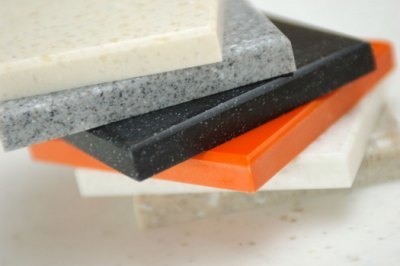
The color can be anything from pure white to jet black
A huge advantage of artificial stone is that it does not limit you in choosing the shape of the table. Look at the photo of one of them to be sure of this.

Composite 2-Tier Kitchen Table
The table top can be round, oval, rectangular, curly, with straight or rounded edges. A hob or sink can be built into it, and the latter can be integral with the work surface.
Note. Underframes of any shape are also cast from artificial stone - even in the form of lion paws or sculptures, if the kitchen design requires it.
How to choose size and shape
What will be a work table for a kitchen made of artificial stone depends on the size and configuration of the work area, the presence of a free-standing stove or built-in hob. This is where all the charm of a stone countertop is manifested, capable of uniting headset modules of any shape without a single seam - angular, U-shaped, built in an arc.

Curly work area in the kitchen
As for dining tables, when choosing them, the area of the room, the number of family members gathering at the same time, as well as the design requirements for color and shape are taken into account.
Shape selection
Ease of use, capacity and even perception of the overall picture of the interior depend on the shape of the table and the type of underframe.
- A rectangular or square shape is the most versatile. Such stone tables for the kitchen can be placed close to the wall, and, if necessary, moved to the center of the room.
- A round or oval table looks more solemn, however, it needs more space - it will look out of place against the wall.
- Semicircular kitchen table will look appropriate against the wall, but triangular kitchen table against the wall will be completely out of place.
- Complex tables are chosen mainly for spacious dining rooms, and support the style of its design.

Figured table in a spacious kitchen-dining room
Council. It is much more convenient to make one central underframe (or two - in the case of an oval or rectangular shape) than four legs in the corners.
Determining the optimal size
There is a kind of instruction for calculating the required table area, according to which for each eater there should be 60 cm of the edge. Knowing this, it is not difficult to determine the length and width of the countertop, taking into account the number of family members and the position that the table will take in the kitchen (along the wall or in the center).
Some difficulties may arise only with determining the diameter of the round table. So that you do not have to remember formulas and make calculations with your own hands, use the following data:
- For four people, a table with a diameter of 90 cm is sufficient;
- For five - 100 cm;
- For six - 120 cm;
- For seven - 130 cm;
- For eight - 140 cm.
For a larger number of eaters, it is recommended to choose not a round, but an oval table.
Conclusion
Reliable, beautiful and durable, kitchen tables with artificial stone justify their considerable cost and difficulties associated with delivery and installation. They can become the main decoration not only of the kitchen, but of the whole house (see also the article "Table-windowsill in the kitchen: design options and possible difficulties").
Gallery




